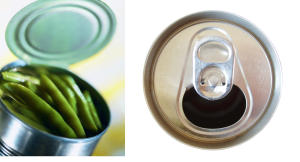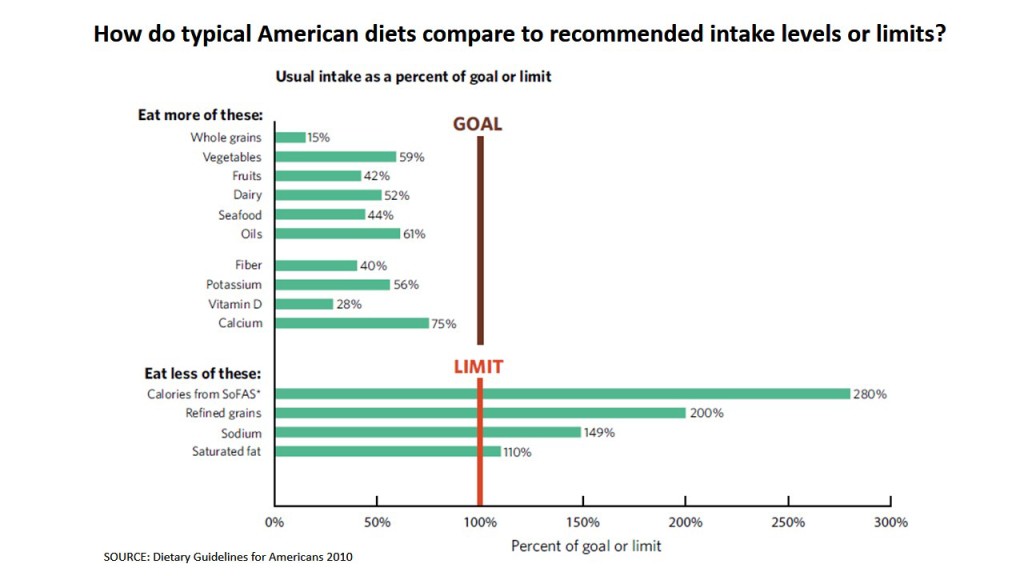This week, read about dietary guidelines and health, BPA and blood pressure, how high intensity intervals boost health, staying fast over 40, Greek yogurt, fatigue and endurance performance, and more.
Are Dietary Guidelines Really Making Us Fat or Sick?
A common theme in many internet posts is how the dietary guidelines are outdated, and are making people fat or sick. Common criticisms include that the guidelines . . .
- “caused the obesity and/or type 2 diabetes epidemic,”
- “are not based on scientific evidence,”
- “recommend carbohydrates/grains and they are the cause of obesity,”
- “recommend a low-fat diet, and this made people fat,”
- “made people replace fat with carbs, and they got fat.”
What’s lacking in these anti-guideline statements is good science.
A critical piece that is ignored in these claims is that most people weren’t following dietary guidelines. The figure below (from the US Dietary Guidelines for Americans – which are similar to other national guidelines) presents a good example of where things are at in the US: Americans were far from the recommendations, eating twice as much refined grains, solid fats (mainly from beef fat, butter, and shortening), and sugars, and less than 50% of the fruit or whole grains recommended (likely vegetables too, but I think that percentage may include french fried potatoes . . . ).
A paper out this week reviews 304 studies, and adds to the evidence that the Dietary Guidelines are not responsible for our health problems (Nutrition Reviews, Dec 2014), and another review published in October shows that Americans haven’t been following the Guidelines.
This point of this post is not to wholeheartedly endorse all aspects of previous and current guidelines, but to highlight the disconnect in the sweeping statements that guidelines have caused health problems. Guidelines have succumbed to industry lobbying, and may not be completely in line with current research. In fact, most dietary interventions I’ve worked on have used the guidelines for the “control” group, while the intervention group is consuming what might be considered a more “disease-protective” diet. We are recognizing that a person’s overall dietary pattern is likely more important to their health than intakes of specific nutrients or foods, and it’s easy to lose sight of the overall picture when critiquing dietary guidelines. But overall, the main themes of the guidelines have been sound nutrition advice: including eating plenty of vegetables and fruit, choosing mostly unprocessed grains, reducing salt, fat and sugar, and getting more physical activity. The recent Dietary Guidelines for Americans is certainly a step in the right direction.
Take home points on dietary guidelines and health:
- Guidelines can’t be blamed for current health problems, as few people have adhered to them
- Guidelines don’t recommend refined carbohydrates, low fiber grains and cereals, or high sugar items – foods that are widely overconsumed and likely contributors to obesity and chronic disease
- Data show that an increase in calories better explains the obesity epidemic than recommendations to reduce fat intake (and contrary to popular belief, Americans did not reduce their fat intake, but they did increase their calorie intake)
- Most people consume refined grains, or grains as part of desserts – which affects health much differently than whole grains, though critics tend to lump all carbs or grains in one category (somewhat like equating candy to unprocessed oats)
- Currently, the most disease-protective dietary patterns are Mediterranean, DASH (Dietary Approaches to Stop Hypertension), or patterns assigned by studies as “Prudent” “High Quality” or “Healthy Eating” – they all contain whole grains and are relatively high in carbohydrates, often demonized by dietary guidelines critics
More Reading . . .
Looking more information? The following individuals have done an excellent job presenting data in relation to dietary guidelines and health.
- No, Dietary Guidelines Are Not Making Us Sick (Colby Vorland)
- Dietitian Reijo Laatikainen has excellent slide presentation debunking the myths that the dietary guidelines are causing health problems here.
- Are Dietary Recommendations Wrong? Inconvenient Data (Kevin Klatt)
- Nutrition Recommendations Constantly Change…Don’t They? (Kevin Klatt)
BPA in Cans and Plastic Bottles Linked to Quick Rise in Blood Pressure
 A new study shows that BPA (Bisphenol A – an endocrine disruptor that acts like estrogen) can seep into beverages and quickly raise blood pressure (Hypertension, December 2014). Canned food and soda are some of the biggest sources of BPA for most people, as most aluminum cans are coated with a vynil-like coating that contains BPA. Many healthy foods like beans, tuna, tomatoes, and many beverages are stored in BPA-containing cans (so are beer, soft drinks, and other beverages).
A new study shows that BPA (Bisphenol A – an endocrine disruptor that acts like estrogen) can seep into beverages and quickly raise blood pressure (Hypertension, December 2014). Canned food and soda are some of the biggest sources of BPA for most people, as most aluminum cans are coated with a vynil-like coating that contains BPA. Many healthy foods like beans, tuna, tomatoes, and many beverages are stored in BPA-containing cans (so are beer, soft drinks, and other beverages).
What About BPA-Free cans? Unfortunately new research shows that we should be wary of “BPA-free” labels: substitute materials may not be safer, yet consumers perceive them as safe and are willing to pay more for them.
Although the risks of BPA are still uncertain, evidence is accumulating showing it does get into our system and may have adverse health effects. Limiting your exposure is a good idea: when possible, choose beverages or food stored in glass/jars, fresh or frozen produce over canned, and consider buying dried beans/legumes instead of canned.
More Links of Interest This Week:
- The 1-Minute Workout: A new study shows that a very short workout performed three times a week for 6 weeks leads to health improvements (actually 10 minutes including warmup, cool-down, and rest between intervals). (Gretchen Reynolds, New York Times reviews PlosONE Nov 3, 2014).
- But Do Inactive Adults Likes Intervals? Yes, according to a new study showing inactive adults prefer high intensity training over continuous exercise. (PlosOne Dec 8, 2014).
- The Power of a Press Release. A British Medical Journal study published this week shows that more than one-third of academic press releases contain exaggerated claims, and that exaggerated press releases tend to be hype more in media stories (BMJ, December 9, 2014; editorial here). Health journalists were all over this study, since media outlets or reporters are typically blamed for sensationalizing research. Here is commentary from health reporters Julia Belluz (Vox.com) and James Hamblin (the Atlantic).
- Fast After 40: Master Your Cross Training. Coach and speedy Master’s runner Pete Magill explains how cross training can improve your running by (1) decreasing fatigue during intense running by lowering blood lactate levels, (2) increasing muscle glycogen stores in non-running muscle fibers, and (3) lessening connective tissue and muscle fiber damage linked to running impact. (Competitor.com)
- Mental Fatigue Impairs Intermittent Running Performance. Don’t calculate splits during intervals or a race! (Med Sci Sports Exerc. 2014 Dec 9).
- Should I Eat Greek Yogurt? 5/5 nutrition experts say yes, mainly for its high protein content, in addition to calcium and potassium, and satiety benefits. They advocate plain varieties (less sugar), and David Katz, MD recommends fat-free. (Time Magazine). Try this Mixed Berry Yogurt with Almonds recipe, which features Greek yogurt and is a fast and easy breakfast, snack, or dessert that is high in protein.
- What is Fatigue? Alex Hutchinson reviews a recent study by Samuele Marcora, and examines the psychobiological model of fatigue that incorporates the brain/motivation/perception into understanding endurance performance. (Alex Hutchinson, the New Yorker)
See More Issues of This Week in Food, Health, and Fitness
.
Share This: